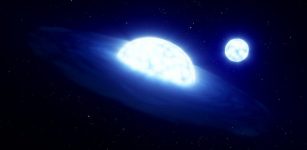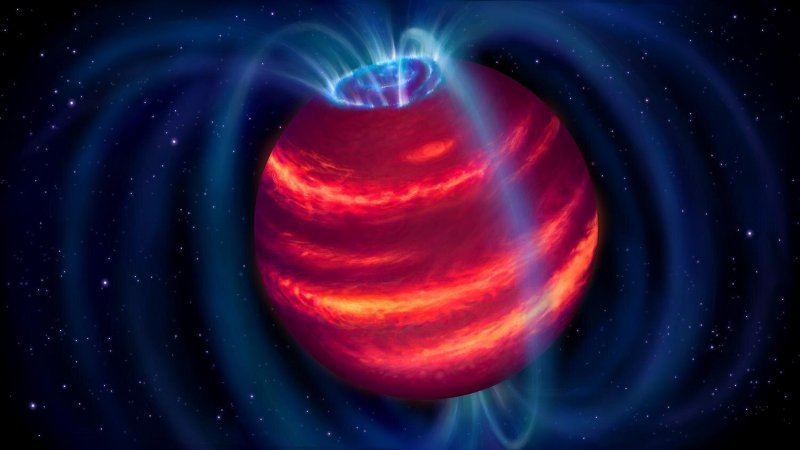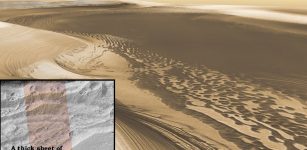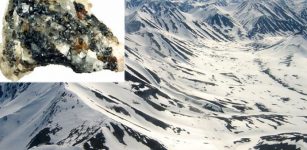Mystery Of Jupiter’s Stunning Color Changes – ‘Solved’
Eddie Gonzales Jr. – MessageToEagle.com – Academics at the University of Leeds believe they could have found the answer to a long-running mystery behind Jupiter’s famous “stripes.”
Images from a ground-based infrared telescope, showing Jupiter at 5 micron wavelength radiation. The remarkable change between May 2001 and December 2011 in the North Equatorial Belt (highlighted between the dashed blue lines) can be seen. Credit: Arrate Antuñano/NASA/IRTF/NSFCam/SpeX
Pictures of the planet are characterized by bands of color, as well as the famous Great Red Spot, but these bands are often seen to move and change—something which scientists have until now not been able to explain.
Now thanks to a new discovery—made possible by NASA’s Juno mission providing incredible new information about Jupiter’s magnetic field—Dr. Kumiko Hori and Professor Chris Jones from the University’s School of Math believe they could have found the answer.
Professor Jones said, “If you look at Jupiter through a telescope, you see the stripes, which go round the equator along lines of latitude. There are dark and light belts that occur, and if you look a little bit more closely, you can see clouds zipping around carried by extraordinarily strong easterly and westerly winds. Near the equator, the wind blows eastward but as you change latitude a bit, either north or south, it goes westward. And then if you move a little bit further away it goes eastward again. This alternating pattern of eastward and westward winds is quite different from weather on Earth.”
“Every four or five years, things change. The colors of the belts can change and sometimes you see global upheavals when the whole weather pattern goes slightly crazy for a bit, and it has been a mystery as to why that happens.”
Scientists already know the changing appearance of Jupiter is somehow linked to infrared variations about 50 km below the gas giant’s surface, and this fresh research has shown that these variations could in turn be caused by waves produced by the planet’s magnetic field, deep within its interior.
Using data gathered by NASA’s Juno mission to Jupiter, which has been orbiting the planet since 2016, their research team was able to monitor and calculate changes in its magnetic field.
Professor Jones added, “It is possible to get wavelike motions in a planetary magnetic field which are called torsional oscillations. The exciting thing is that when we calculated the periods of these torsional oscillations, they corresponded to the periods that you see in the infrared radiation on Jupiter.”
The amazing longevity of Juno in the harsh radiation environment of Jupiter has seen the probe stay in orbit for much longer than originally planned. This has led to the Leeds researchers getting magnetic field data over a much longer period, which is much more useful to their work.
By looking at the magnetic field over several years, they have been able to track its waves and oscillations and have even been able to follow a specific spot of magnetic field on Jupiter called the Great Blue Spot. This spot has been moving eastwards, but the latest data shows that movement is slowing—leading the Juno team to believe this is the beginning of an oscillation, with the movement slowing before it reverses and starts going westwards.
The work was led by Dr. Hori, who worked with Professor Jones at Leeds before moving to a new post at Kobe University in Japan, along with Professor Steve Tobias at Leeds, Professor Leigh Fletcher at the University of Leicester and Dr. Arrate Antuñano at the Universidad del País Vasco in Spain.
It has seen them produce an explanation for the long-running mystery of Jupiter’s changing bands and stripes and fill in the missing link between the two largest areas of Jupiter study—scientists interested in the planet’s weather and what happens on the surface, and those working on the deep interior.
Dr. Hori said, “There remain uncertainties and questions, particularly how exactly the torsional oscillation produces the observed infrared variation, which likely reflects the complex dynamics and cloud/aerosol reactions. Those need more research. Nonetheless, I hope our paper could also open a window to probe the hidden deep interior of Jupiter, just like seismology does for the Earth and helioseismology does for the sun.”
For Professor Jones, the breakthrough is the culmination of a lifelong passion for Jupiter. He said, “I am incredibly pleased that NASA finally managed to get to see Jupiter’s magnetic field in detail. I have been studying Jupiter for an exceptionally long time and I got interested in what lies below the surface of Jupiter when I was a child—it has been a 60-year progression.”
Written by Eddie Gonzales Jr. – MessageToEagle.com Staff











